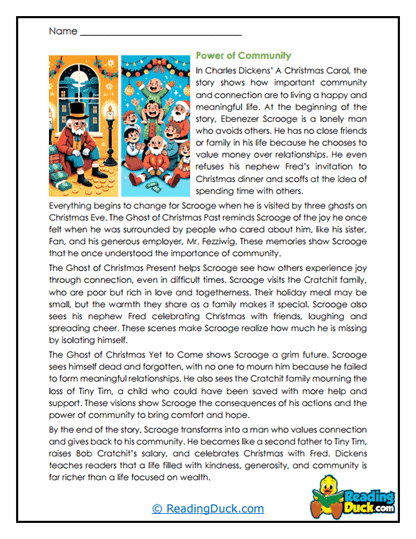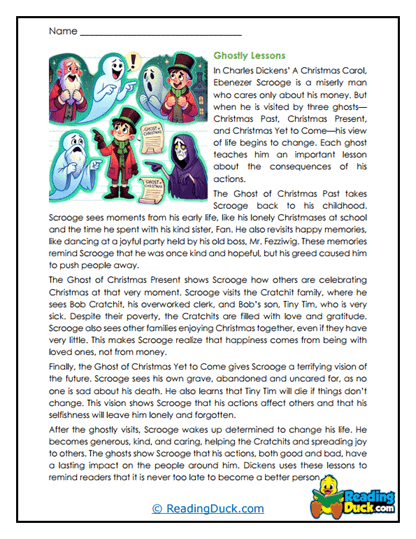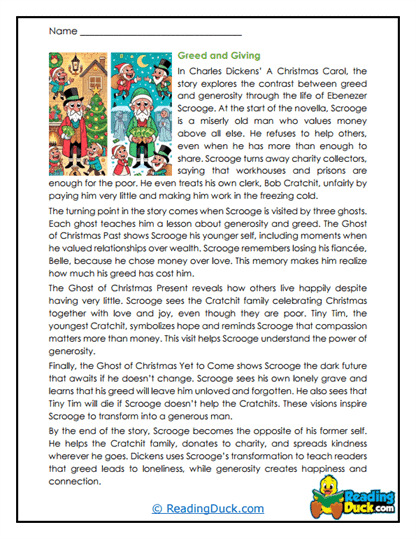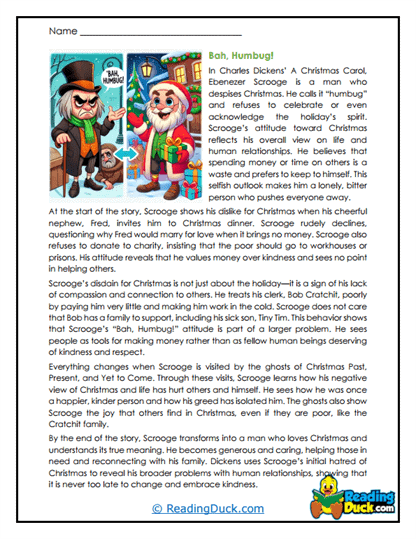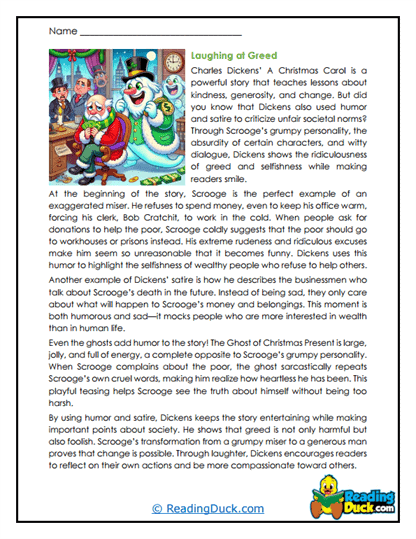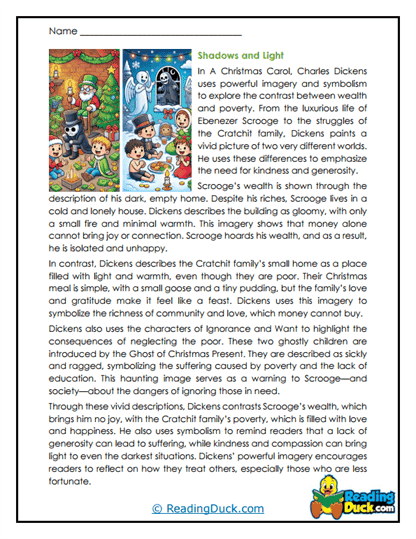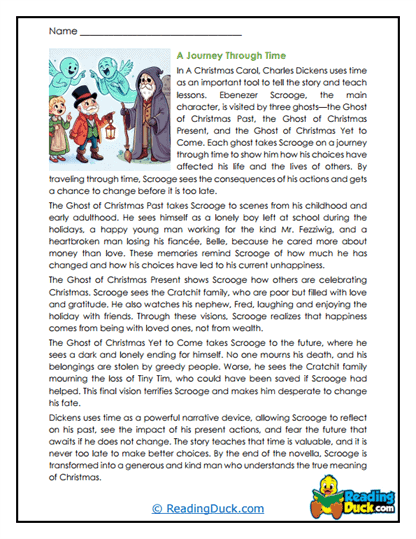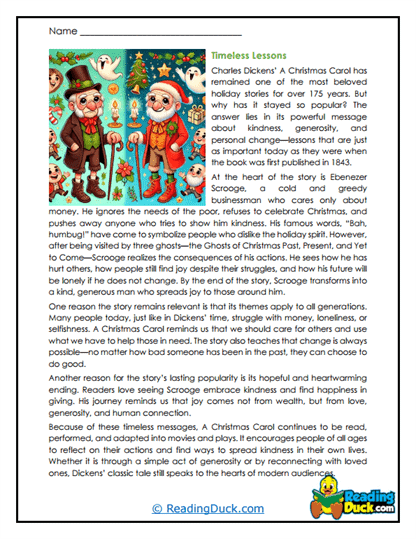A Christmas Carol Worksheets
About Our A Christmas Carol Worksheets
This collection of reading comprehension worksheets is thoughtfully designed to help 4th-grade students engage with the beloved classic A Christmas Carol by Charles Dickens. The story of Ebenezer Scrooge is one of transformation, kindness, and the true spirit of generosity-messages that remain relevant for young readers today. However, the original text can be challenging for elementary students due to its older language and complex sentence structures. To ensure accessibility, each worksheet presents an adapted passage inspired by the novel, using clear, age-appropriate language while preserving the heart of Dickens' storytelling. This allows students to connect with the story in a way that is both meaningful and easy to understand.
These worksheets do more than just introduce students to a classic piece of literature; they immerse them in Scrooge's journey, guiding them through key moments that showcase his remarkable transformation. At the beginning of the story, students encounter Scrooge as a grumpy and selfish man who cares only for money. As they progress through the passages, they witness his encounters with the ghosts of Christmas Past, Present, and Future, who help him realize the consequences of his unkindness. By analyzing these pivotal moments, students gain insight into how and why Scrooge changes, fostering deeper comprehension and critical thinking skills.
Beyond understanding the plot, these worksheets encourage students to engage with the moral lessons of A Christmas Carol. The story teaches powerful values such as compassion, generosity, and the importance of human connection. Through guided comprehension questions and discussion prompts, students reflect on Scrooge's choices and consider how they apply to their own lives. For example, they might explore how small acts of kindness-such as Bob Cratchit's unwavering patience or Tiny Tim's hopeful outlook-can make a big difference. These activities help students develop empathy and social awareness, making their reading experience even more meaningful.
This worksheet collection supports literacy development by focusing on key reading skills, ensuring that students not only read A Christmas Carol but also deeply understand and engage with its themes and characters. The activities provided in these worksheets encourage students to think critically, expand their vocabulary, and improve their overall reading fluency. By working through the different exercises, students develop essential literacy skills that will help them become more confident, thoughtful readers. Each of the following areas plays a vital role in their growth as young learners.
Reading Comprehension
Understanding a story goes beyond simply reading the words on a page-it requires grasping the plot, characters, and themes that bring the narrative to life. These worksheets help students track the events of A Christmas Carol, ensuring they comprehend the transformation of Ebenezer Scrooge from a selfish miser to a kind-hearted man. Through multiple-choice, short-answer, and discussion-based questions, students will practice recalling important details, summarizing key moments, and identifying cause-and-effect relationships. By engaging with these exercises, they build their ability to follow a structured narrative, recognize the main idea, and draw conclusions based on the text.
Vocabulary Building
Dickens' original language can be quite complex for young readers, but that doesn't mean they should miss out on its rich vocabulary. These worksheets introduce challenging yet age-appropriate words, providing definitions, contextual examples, and practice exercises to help students understand and use new terms. Activities such as matching exercises, sentence completions, and synonym/antonym practice ensure that students not only recognize these words in the text but can also incorporate them into their own writing and conversations. Developing a strong vocabulary improves overall reading comprehension, as students become more comfortable with the language used in classic and modern literature.
Critical Thinking
Reading is more than just recognizing words-it's about analyzing and interpreting ideas. These worksheets encourage students to think beyond the text by exploring Scrooge's actions, motivations, and character growth. By asking students to reflect on why Scrooge is the way he is and how his experiences with the Ghosts of Christmas change him, these activities develop deeper analytical skills. Additionally, students are prompted to make real-world connections, considering how Scrooge's transformation teaches lessons about generosity, kindness, and personal growth. This level of engagement helps young readers become more thoughtful and reflective learners.
Inferencing & Prediction
Good readers don't just absorb information-they actively engage with the text by making educated guesses and drawing conclusions. These worksheets challenge students to infer character emotions, predict future events, and connect details to form logical interpretations. For example, students might be asked to predict how Scrooge will react when he sees his own grave or infer how Bob Cratchit feels about his employer at different points in the story. By practicing these skills, students develop the ability to read between the lines, recognize implied meanings, and anticipate story developments-all of which are crucial for becoming strong, independent readers.
Fluency Practice
Reading fluency is the ability to read with speed, accuracy, and expression, and it is a crucial skill for developing confidence in young readers. These worksheets provide structured reading passages that allow students to practice reading aloud while focusing on proper pacing and intonation. By encountering dialogue and descriptive passages from A Christmas Carol, students learn to recognize punctuation cues, adjust their tone based on context, and express emotion while reading. Improved fluency leads to better comprehension and overall enjoyment of reading, making it easier for students to engage with more challenging texts in the future.
Active Engagement with the Story
These worksheets ensure that students do more than just passively read A Christmas Carol-they interact with it in meaningful ways. By working through comprehension exercises, discussing key themes, and participating in creative writing prompts, students become personally invested in the story and its characters. This level of engagement turns reading into an active experience, helping students develop both their academic skills and their ability to relate literature to their own lives. By making reading both fun and educational, this worksheet collection provides students with the tools they need to become confident, curious, and thoughtful readers.
Brief Summary of "A Christmas Carol"
A Christmas Carol is a famous story written by Charles Dickens in 1843. It is one of the most well-known Christmas stories of all time! The book teaches us about kindness, love, and the true meaning of Christmas.
The main character is Ebenezer Scrooge, a rich but grumpy old man who does not like Christmas at all. He only cares about money and refuses to help others. But one Christmas Eve, something magical happens-Scrooge is visited by three ghosts who show him the past, present, and future. These ghosts help Scrooge understand why it is important to be kind and generous. By the end of the story, he changes his ways and becomes a much better person!
Ebenezer Scrooge is a mean, selfish, and lonely man who does not care about Christmas or other people. He only thinks about making money and refuses to help those in need. Even when his cheerful nephew Fred invites him to Christmas dinner, Scrooge rudely refuses. He is also very unkind to his employee, Bob Cratchit, who works hard but is paid very little.
On Christmas Eve, something strange happens-Scrooge is visited by the ghost of Jacob Marley, his old business partner. Marley warns Scrooge that if he does not change his greedy ways, he will regret it forever. He tells Scrooge that three ghosts will visit him that night.
The Ghost of Christmas Past takes Scrooge back to his childhood. Scrooge sees himself as a lonely boy and then as a young man who cared more about money than love. He realizes that he lost many chances to be happy.
The Ghost of Christmas Present shows Scrooge how people around him celebrate Christmas. He sees Bob Cratchit's family, who are poor but happy. Scrooge also meets Tiny Tim, Bob's sick but joyful son. Tiny Tim is kind and loving, even though his family struggles. This makes Scrooge feel guilty for not helping others.
The Ghost of Christmas Yet to Come shows Scrooge a sad future. Scrooge sees that when he dies, no one cares. People are even happy that he is gone! He also sees Tiny Tim's death, which makes him heartbroken. Scrooge is scared and begs for another chance to change.
When Scrooge wakes up on Christmas morning, he is overjoyed! He realizes he still has time to be a better person. He immediately becomes kind and generous. He donates money, treats people with love, and surprises the Cratchit family with a big Christmas feast. He even takes care of Tiny Tim, who gets better because of Scrooge's help. From that day on, Scrooge is a new man-full of Christmas spirit, love, and kindness!
A Christmas Carol is a heartwarming story about kindness, change, and the true meaning of Christmas. Scrooge starts as a mean and lonely man but learns that love and generosity bring real happiness. By the end of the story, he becomes a caring and joyful person, showing that anyone can change for the better.
